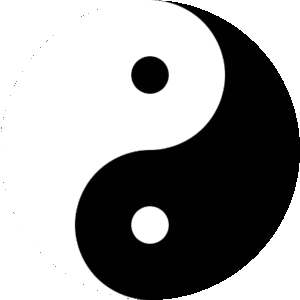4.2 True and False
Classical Logic assumes that every proposition is either true or false and not both. We can use this to create a truth table for negated statements, including those with multiple negations, and to prove valid the rule of double negation. This allows us to see how a truth table with multiple logical connectives works.
Table of Contents
4.2.1 The Laws of Non-Contradiction and Excluded Middle

In classical logic, there is no gap between true and false.
Two Truth Values
Following the “Standard View” discussed earlier, we will assume that there are exactly two truth values which a proposition can have: True and False. This is sometimes called bivalence. There are other logics which allow more than two truth values, but this course focuses on classical logic, which has only two.
In formal logic we will not be concerned with whether propositions are actually true or false, however. Instead, we will be concerned with hypothetically what the truth (or falsity) of one statement would entail about the truth (or falsity) of another statement. When formal logic considers the statement, “Bob is not honest”, we won’t be concerned with who in the world Bob is or whether he is in fact honest. Instead, we’ll be concerned with the logical relationships this statement has to other statements, such as the relationship where if “Bob is not honest” is true, then “Bob is honest” is false, and if “Bob is not honest” is false, then “Bob is honest” is true.
Two Laws of Logic
One basic principle of our logic, or “law” of logic, is the law of excluded middle, which says that every statement is either true or false. No statement is neither true or false. This is simply how we’ve defined a statement earlier. Some sentences are neither true nor false, like the sentence “Give me a cherry soda, please.” Some very unusual sentences which look like statements must be neither true nor false, like the sentence, “This sentence is false.” These sentences are not statements.
The second basic principle of logic is a principle of logical consistency, the law of non-contradiction. The law of non-contradiction says that no proposition is both true and false. If you claim to have one income on a tax return, and your claim is false, then your claim isn’t also true; if your claim is true, then it isn’t also false. Of course, a sentence like “it is raining” can be true in some places and false in some other places, or true at some times and false at other times. This is because which proposition “it is raining” expresses is relative to the context. Once we specify the place and time and context, however, the proposition expressed by “it is raining” can’t be both true and false.
The law of non-contradiction is an expression of the more general intellectual virtue of consistency. Consistency is the intellectual virtue of treating like cases alike. For instance, if we acknowledge that the form of an argument is valid, then we can’t also claim an argument is invalid; we can’t claim an argument with a certain form is valid when we make it but invalid when our opponent makes it. The virtue of consistency applies not only to formal logic but also to law and morality: the law isn’t consistent if it makes the same action both legal and illegal, and one can’t consistently claim that a moral principle applies to other people without applying it to oneself.
4.2.2 Truth Tables: Positive and Negative Claims

The negation sign ‘flips’ the truth value like flipping on or off a light switch.
Truth Tables and Negation
After we have symbolized claims, we can map out all of the possible true values they might have using a truth table. Let’s start by writing the truth table for a negated statement.
Let
J = “Jason lives on the island of Java.”
Then,
~J = “Jason does not live on the island of Java.”
We can create a truth table to show the relationship between the truth value of J and the truth value of ~J. For simplicity, we’ll start abbreviating “True” with the letter T, and “false” with the letter F.
| J | ~J |
| T | F |
| F | T |
The left-hand column of the truth table shows the two possible truth values for J: in the first row, J is true; in the second row, J is false. The right-hand column shows the truth values which ~J would have given each truth value for J. If J were T, then ~J would be F. If J were F, then ~J would be T. We don’t need to know whether Jason actually lives on Java or not to understand this logical relationship.
In fact, we don’t need to know anything about the meaning or content of a statement in order to know that this relationship holds. Let P stand for any statement that you like: any sentence you can come up with which expresses a proposition. The following truth table will hold:
| P | ~P |
| T | F |
| F | T |
This truth table gives us a “definition” of the ~ sign: the ~ sign “flips” the truth value of whatever sentence it is applied to, from true to false or from false to true. We can apply this to any statement we like. The same truth table will always hold for negation.
4.2.3 Negation and Double Negation

Negations or opposites cancel each other out to produce a harmonious positive.
Truth Tables for Multiple Negations
We can apply multiple negation signs (~) in a row, and the effect of those negation signs remains the same: they “flip” the truth value of whatever follows them from T to F or from F to T. Here is the truth table for ~~P:
| P | ~P | ~~P |
| T | F | T |
| F | T | F |
Notice that we put the most basic, atomic sentence on the left side (P), and then build in complexity from left to right, so that for each column of the truth table on the right we derive its truth value from the column to the left. We can use this principle to create truth tables for as many negations as we like:
| P | ~P | ~~P | ~~~P | ~~~~P | ~~~~~P |
| T | F | T | F | T | F |
| F | T | F | T | F | T |
Each application of the ~ sign “flips” the truth value of the sentence to T to F or from F to T.
The ~ sign is called a “logical connective”. We will study other logical connectives in later modules. Whenever a sentence has multiple logical connective, we put the statement with the most logical connectives on the right, and then one-by-one we remove logical connectives so that statements with fewer logical connectives are towards the left.
Double Negation (DN)
We can use the truth table given earlier to prove the validity of another rule of logic, the rule of Double Negation. The rule of double negation allows us to add or remove a pair of ~~ signs, provided that it is always a pair which we remove and never a single negation sign. The rule is valid, because if P is true, then ~~P is true, and if ~~P is true, then P is true. We cite the prior line and use the abbreviation (DN):
1. P
2. ~~P (1, DN)
1. ~~P
2. P (1, DN)
In other words, if it is not not raining, then it is raining, and if Sam is a Republican, then Sam is not not a Republican. If you aren’t not drinking coffee, then you are drinking coffee.
Notice, however, that the rule of Double Negation does not apply to all “negative” words which are within a sentence. For instance, “John is not unhappy” does not entail that “John is happy”, because someone who is doing “just okay” could not be happy without being unhappy. Similarly, “Jane does not eat fish which isn’t cooked” does not entail “Jane eats fish which is cooked”; Jane might be a vegetarian. The rule of double negation only applies when each negation applies to the whole statement, rather than just one word or phrase within the statement. Sometimes we can use the word “not” to apply just to a predicate, and not to a whole statement, as when you say of someone with half of a head of hair, “well, he is not not bald”, which doesn’t entail that he is bald (as double negation would suggest), but just that he isn’t unbald in the sense of having a full head of hair. When we use the word “not” in this class, we’ll mean it to apply to the whole statement.
Submodule 4.2 Quiz
Licenses and Attributions
Key Sources:
- Watson, Jeffrey (2019). Introduction to Logic. Licensed under: (CC BY-SA).
Next Page: 4.3 Clarifying Claims
